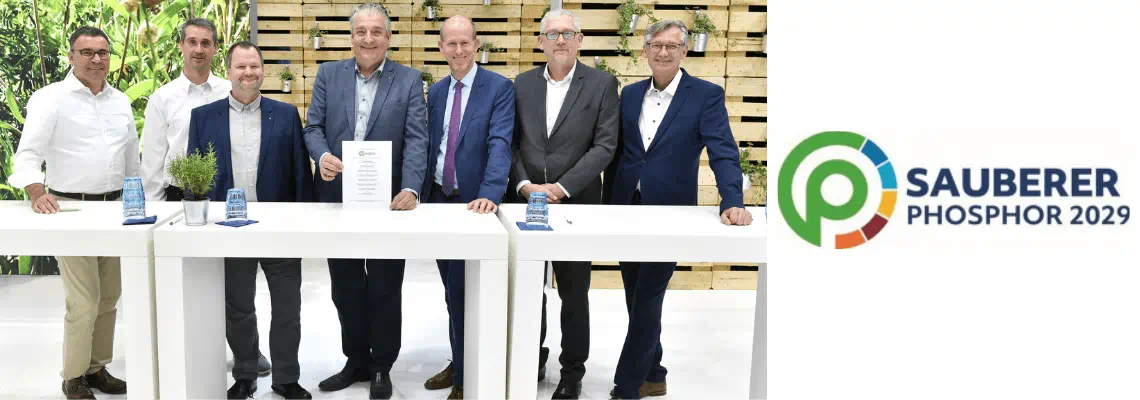A new initiative from several companies in Germany have come together to promote phosphorus recovery technologies for 2029 deadline.
The time has come
Several companies in Germany have joined forces under the Sauberer Phosphor 2029 (Clean Phosphorus) initiative that will see them champion new recovery and recycling processes.
The initiative relates directly to the German Sewage Sludge Ordinance, which was amended to begin requiring the recycling of phosphorus from sewage sludge ash in 2029.
Founding members of Sauberer Phosphor 2029 include EasyMining Germany, Gelsenwasser, MSE Mobile Schlammentwässerungs, PTC-Parforce-Technology Cooperation, Parforce Engineering und Consulting, KSR Klärschlammrecycling Bitterfeld-Wolfen, Phosphorgewinnung Schkopau and Ragn-Sells.
“Three things matter when it comes to phosphorus recycling; quality, volume and reliability.”
These companies collaborated to create a paper entitled “Sauberer Phosphor 2029” which outlines seven agreed-upon qualities for clean phosphorus recovery:
- The defined targets and intentions for phosphorus recovery in accordance with the Sewage Sludge Ordinance can be achieved
- Does not cause any additional accumulation of pollutants on fields, arable land, or cultivated areas
- Separates phosphorus recovery into product and residual material fractions in a manner that assures quality regardless of the composition and pollutant load of the starting material
- Fosters independence from the import of phosphorus through reliance on domestic sources
- Produces clean and universally applicable, marketable phosphorus products that are needed and further processed in the established structures of the phosphorus processing industry
- Removes the pollutant substances from the material cycle
- Enables separate recovery of as many valuable materials as possible from the ashes.
Speaking on the agreement, Christian Kabbe, CEO of EasyMining Germany, said: "Nutrient recycling is essential but can only be considered if conducted in a sustainable way.
"This is why this initiative is so important. Three things matter when it comes to phosphorus recycling; quality, volume and reliability.”
Why is phosphorus important?
Phosphorus is a vital ingredient in fertilisers and an essential additive for livestock feed.
Its primary source is phosphate rock, a non-renewable resource that’s mainly mined outside of Germany.
Phosphorus is absorbed by humans through food consumption in the form of phosphates and is released again, especially through urine, thus entering wastewater.
It is removed from wastewater in treatment plants and finally ends up in sewage sludge.
However, new processes to recover phosphorus from incinerated sewage sludge are being developed and implemented into large scale operations. Sewage sludge ash is not only a potential circular source of phosphorus but a domestic one as well.
There are only a few phosphate deposits worldwide. The largest deposit of phosphate ores (rock phosphates or apatite) is in Morocco with other large deposits located in Russia and China.
In the European Union and many other regions of the world, phosphorus has been declared a critical raw material due to the lack of domestic deposits and the high dependence on imports.
The recovery of phosphorus from residual materials such as sewage sludge or ash as a domestic source of phosphorus is therefore a key area of interest.
H2 heading: 2029 phosphorus ambitions
Currently, Germany has set the target to thermally treat sewage sludge and to recover phosphorus from 1 January 2029.
This means that from this date onwards agricultural recycling via co-incineration as an option for the disposal of sewage sludge will no longer be possible for phosphorus.
“There are only a few phosphate deposits worldwide.”
For recovery to be implemented at a sewage treatment plant, the phosphorus content in the sewage sludge must be reduced to less than two per cent P (20g/kg DM) remains in the sewage sludge dry matter.
Sewage sludge ash consists of a large number of different, complex material and mineral phases formed by incineration.
The phosphorus is embedded in some of these material and mineral phases and has to be extracted in a complex way.
PTC-Parforce-Technology Cooperation has developed PARFORCE technology which is a wet-chemical process that separates most pollutants and impurities and produces phosphoric acid which electro-dialysis is used to purify.
The 'Sea of Opportunity', a documentary produced by the EU, showcased innovative technologies in wastewater and agriculture to drive nutrient recovery across the Baltic Sea Region.
It highlighted three promising EU technologies that can recapture phosphorus and nitrogen for reuse in agriculture are featured in the documentary.
Related content
- Video:'Sea of opportunity' for phosphorus reecovery in the Baltic region
- Wastewater upgrade reduces phosphorus
- Sweden and Germany kickstart phosphorus recovery drive






